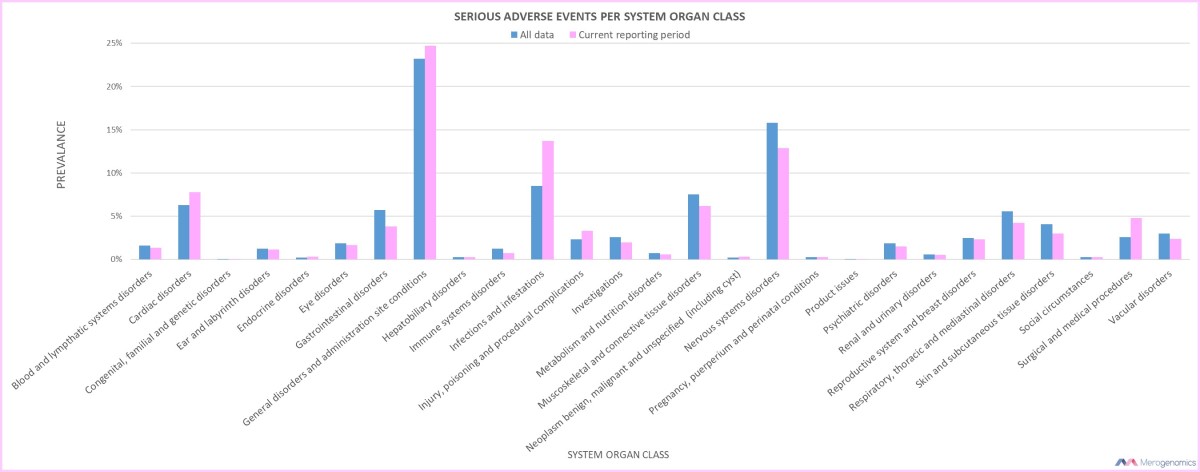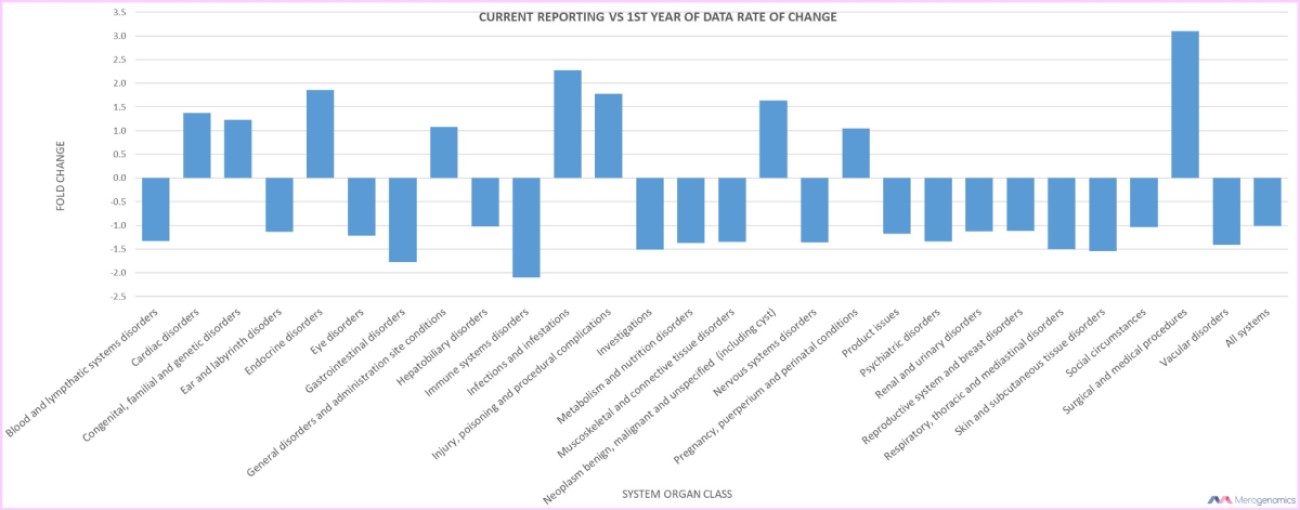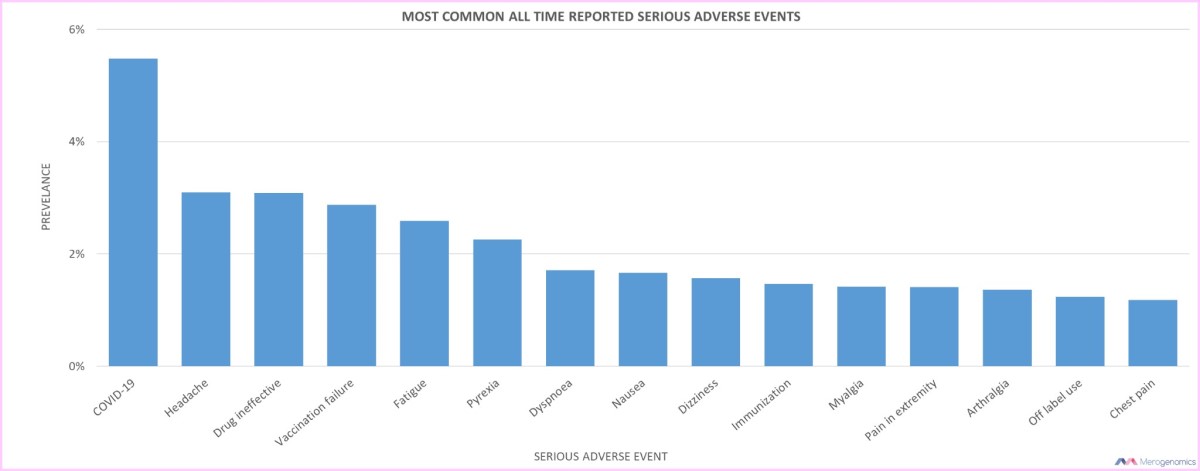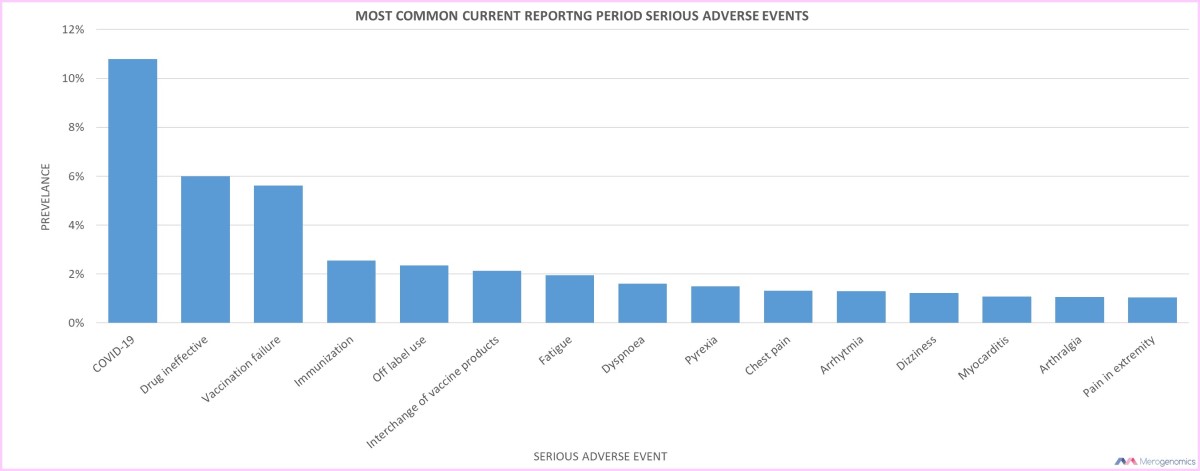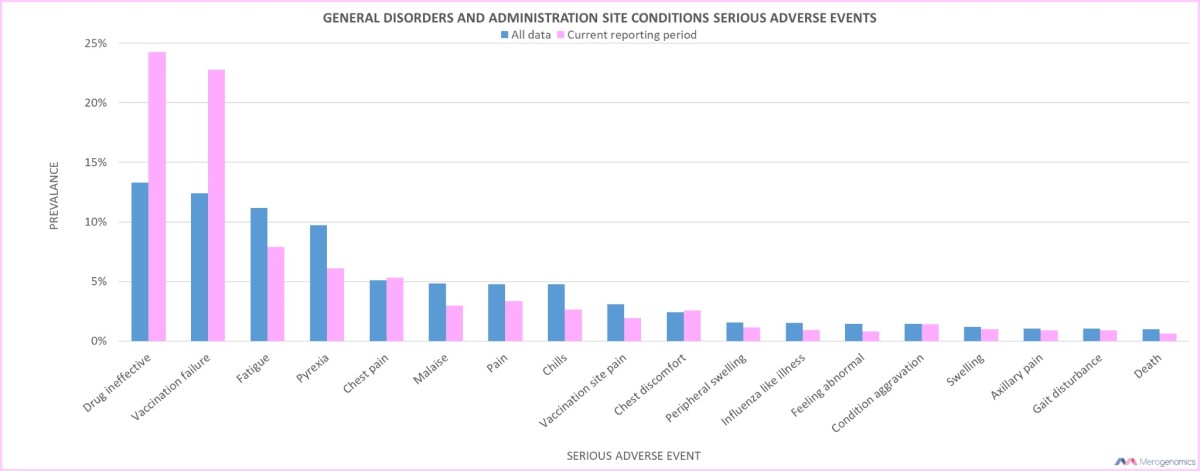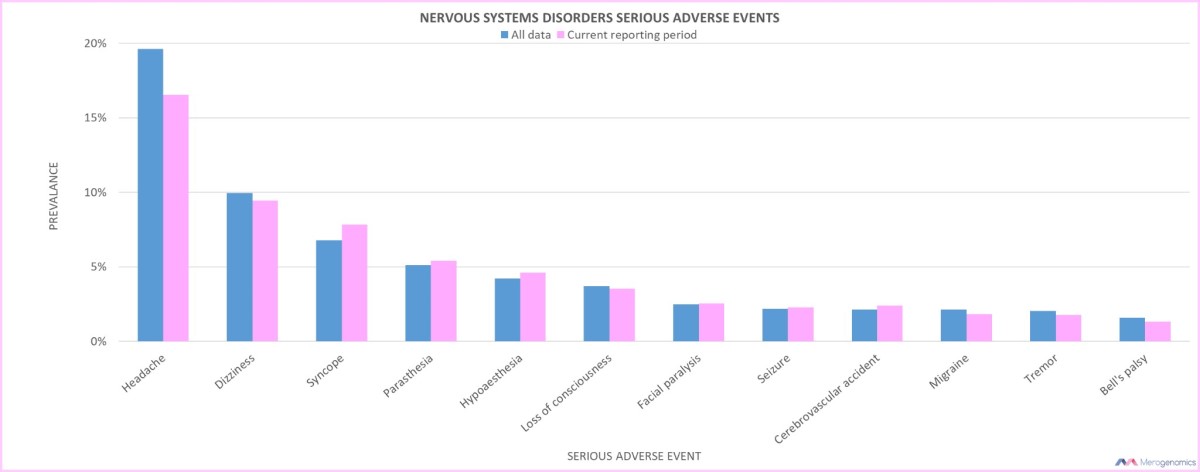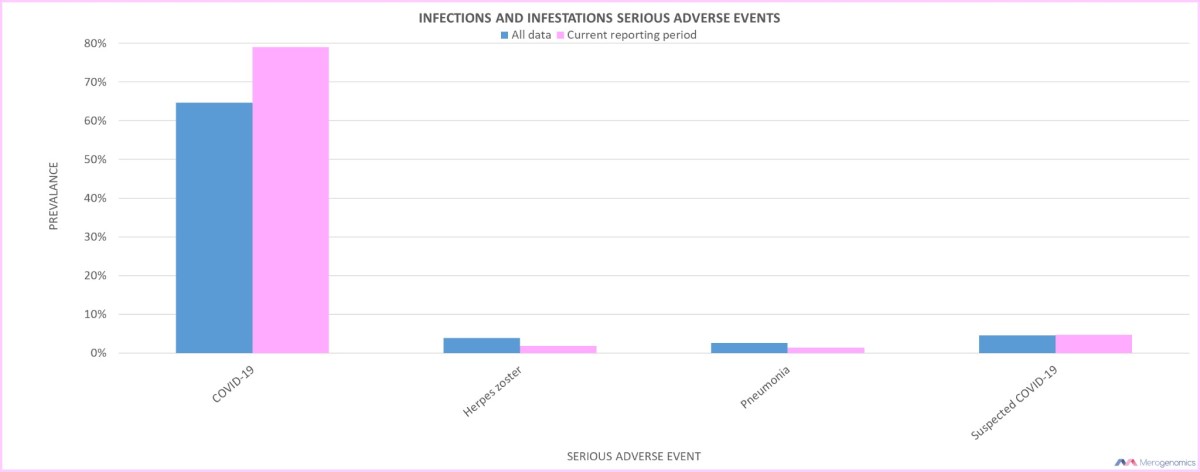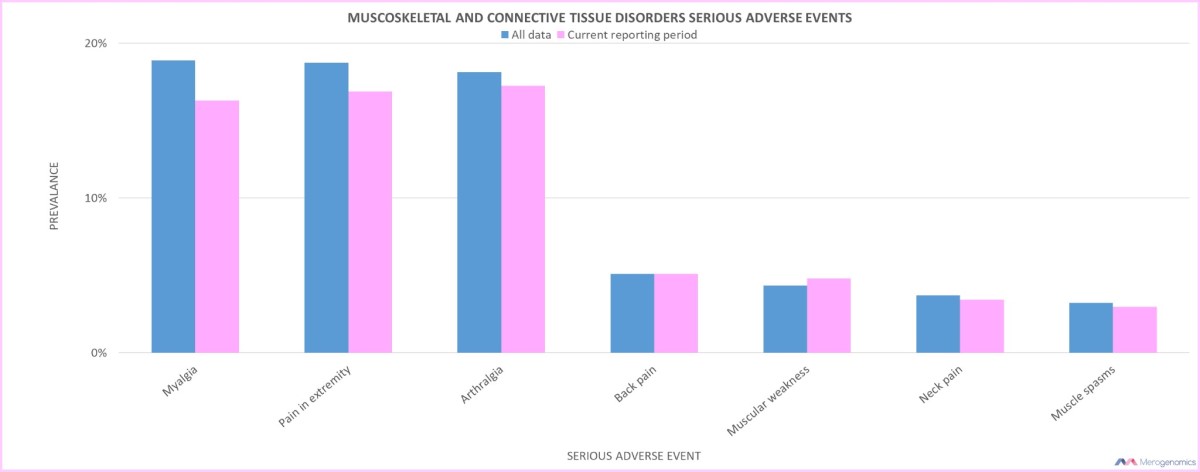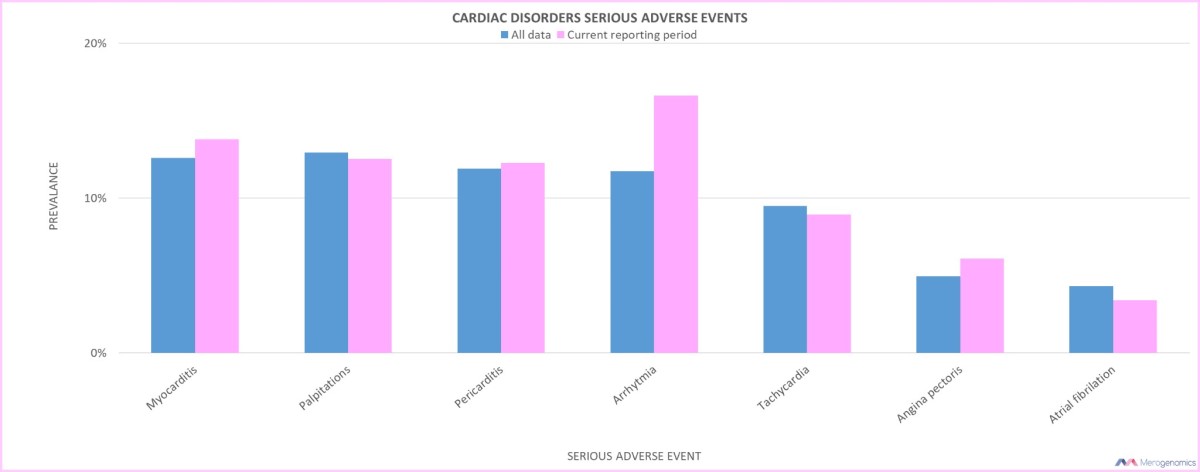
Most common mRNA vaccines serious adverse events
Dr.M.Raszek
Pfizer reported vaccine side effects report is a treasure trove for doctors
Recently Merogenomics did a deep dive into a now-retracted paper on mRNA vaccines issues which at the time of publication was one of the largest assembled collection of troubles regarding the design and execution of mRNA COVID-19 vaccine clinical trials as well as their subsequent failure to deliver post mass roll out to the public.
One of the points discussed in that review article was the 2022 Pfizer document that tracked adverse events among vaccinated individuals. The nearly 400 pages report showed what side effects were captured in the first half of 2022 and compared these numbers against the entire timeline of collecting such information, which would have been since mass vaccination began in December 2020.
Therefore this document acts as one of the most definitive sources of information on what kind of side effects might be expected within the first 1.5 years post-vaccination. As society is slowly opening up to the concept that we do have vaccine-injured people, doctors might benefit from understanding what Pfizer itself has documented as a potential proxy of which biological systems are most likely to be affected if side effects are to be experienced. For this reason, we wanted to graph some of this available data to clarify the picture.
In total, nearly 5 million adverse events were reported by Pfizer by June 2022, with nearly 1.6 million in the current reporting time period of the first half of 2022. This information however does not inform us at all about the frequency of vaccine-related side effects in a population. However, keep in mind that by mid-2022 billions of mRNA shots have been administered worldwide, thus the actual rate of side effects in a general population could be very small. Whatever it might be, this data cannot inform us of how likely a person is to experience a side effect post-vaccination, only that in the seemingly event that this happens, what the side effects might be.
In this summary, we only focus on serious adverse events, thus side effects that could impact person’s ability to continue normal life, result in hospitalization or extending a hospital stay, result in disability, affect pregnancy or proper development of the fetus. Thus we are looking at the most serious potential impacts only.
Most commonly affected body systems by mRNA shots
Here is which body systems were impacted in the entire time frame in comparison to the latest reporting period of 2022.
Different organ systems are affected disproportionately, with the greatest impact on general disorders and administration site. This makes sense since generic side effects are most likely to be reported when experiencing powerful immune system modulation. But we can also see other peaks of the most frequently affected systems, with nervous system disorders, followed by infections and cardiac disorders. We will look at the most commonly reported side effects in all of these.
As you can see, a similar pattern emerges for the entire reporting period of 1.5 years of observation compared to the latest 6 months. What will stand out is that infections appear to increase in the latest period, and surgical procedures appear to be more frequently affected. The elevation in infections also makes sense as building evidence indicates that the more mRNA injections a person receives, the more likely they are to experience subsequent SARS-CoV-2 infection if measured over an extended time (as opposed to the short time period immediately after the booster shot). On the other hand, it is a welcome sight to see that nervous system disorders are less frequently reported to be affected as time progresses, as well as gastrointestinal and respiratory disorders.
How mRNA vaccine side effects change over time
To gain a better perspective of how reported side effects might have changed over time, we compared the latest reporting period of the first half of 2022 to the first year of reporting in 2021.
In this graph, a value of 1 or -1 means no change between the time periods and anything beyond that value means that given side effects were either reported more or less frequently between the two time periods. This indicates that surgical procedures reported side effects increased 3-fold in the first half of 2022 in comparison to 2021. Infection side effects increased nearly 2.3-fold. But such comparison also reveals changes that might go unnoticed due to a small number of reported side effects, such as endocrine disorders, which while reported quite infrequently, have shown a 1.9-fold increase between these time periods. In a similar vein, while vaccine-related cancers have been rarely reported, there is a 1.6-fold increase between the reported time periods.
Conversely, the largest decrease in side effects between the two time periods is immune system disorders with a 2.1-fold observed decrease. The second largest decrease of any specific organ system was in gastrointestinal disorders with a 1.8-fold drop in reported side effects between 2021 and 2022.
It would be interesting to see how these changes in reported side effects continue over time into the current moment so that we could understand the immediate possible complications versus long-term potential problems.
What are the most common reported serious adverse events post mRNA shots?
As you can see, COVID-19 infection was the most commonly observed serious adverse event. For this to be reported as serious, clearly we are discussing symptomatic infections with serious consequences such as hospitalization. This is also perhaps not surprising as infection soon post-vaccination can indeed result in worsening of experienced symptoms by the vaccinee. Moving down the list of the most common serious adverse events, this is a familiar list of symptoms such as headache, fatigue, pyrexia (high temperature), dyspnea (difficulty breathing), nausea, dizziness, myalgia (muscle pain), arthralgia (joint pain) and chest pain. Basically, the most common serious side effects appear to be a serious fever.
The interesting other reported side effects are ineffective use of drugs and vaccine failure. Without further details, it is difficult to understand the meaning of such reported serious side effects. Perhaps this could indicate that vaccination itself might have tampered with the effectiveness of certain medications. Vaccine failure could be due to subsequent reported infection but then this would be already captured by COVID-19 reported infection, thus another possibility would be the inability to mount immune response to the vaccine antigen (the spike protein). But what would differentiate lack of immune response as a serious side effect in some and not in others would then not be clear at all. Due to the lack of any further explanation, we have to leave this behind.
Other terms that are hard to understand without context are immunization and off label use. The assumption here is that immunization with any vaccine post-COVID-19 vaccination resulted in serious side effects. Off label use means the use of a medical intervention that is not officially approved for that purpose. This is not unusual as doctors are supposed to have the freedom to use available options to help the patient based on their judgment of the patient’s medical situation. It is not clear if this means that the COVID-19 vaccination was used off label itself or if other off label interventions caused side effects that would not be expected but became apparent due to COVID-19 immunization. Again, we have to leave this alone to move on to the more obvious reported side effects.
2022 reporting period Pfizer serious adverse events
What were the most common side effects in the latest reporting period?
What jumps out right away for 2022 in comparison to the historical averages is that serious COVID-19 infection is reported more frequently (nearly double the historical average). Ironically, this is the exact opposite trend we would expect to see for COVID-19 vaccines. The symptoms are very similar with change in frequency and their order. But we have two new adverse events that did not make the historical top 15 side effects: interchange of vaccine products (adverse events observed when different types of COVID-19 vaccines were used in an individual) and myocarditis (inflammation of the heart). What dropped out is headache and nausea.
Now let us look at the most commonly reported serious adverse events for the body systems that were most frequently affected by the mRNA shots. Top side effects that were reported more than 3000 times are provided in each category.
General disorders and administration site conditions
Looking through general disorders and administration site conditions, you can see that because this body system was responsible for some of the most frequently reported side effects the list is very similar to the two previous graphs above. Few new terms show up that continue to mimic fever-like side effects post-vaccination. The last three deserve a further explanation, with axillary pain being a pain in the armpits. The gait disturbance was a surprise side effect of the top 18. The last most serious reported side effect is death due to vaccination. In total, by mid-2022, death was reported 2995 times, and that included 646 deaths in the most recent reporting period.
Nervous system disorders
This organ system accounts for the second largest reported side effects post mRNA injections and thus deserves a deeper look at what kind of serious side effects are most commonly reported. Headache is the most commonly reported issue that made the all time historical list along with dizziness. Let’s define some of the terms for the general public. Syncope is fainting, paraesthesia is a tingling sensation in extremities, hypoaesthesia is numbness or loss of sensation and Bell’s palsy is muscle weakness in one side of the face.
Infection and infestations
This category provides certain context of what are the most commonly reported side effects due to infections post vaccination with COVID-19 due to SARS-CoV-2 infection being reported most frequently. This is followed by herpes zoster (shingles), pneumonia and suspected COVID-19. The assumption here is that suspected COVID-19 resulted in symptoms of COVID-19 but without PCR confirmation. Clearly serious COVID-19 is the most commonly encountered problem with other conditions pailing in comparison.
Musculoskeletal and connective tissue disorders
Musculoskeletal and connective tissue disorders is an interesting category in that numerous serious side effects are reported at a similar frequency.
Cardiac disorders
Looking at specific serious side effects under the grouping of cardiac disorders, we already see the familiar myocarditis. Unfortunately, many worrisome side effects are reported quite frequently including palpitations, pericarditis (inflammation of the heart lining), and arrhythmia (irregular heartbeat) all reported at more than 10% frequency of all side effects encompassing cardiac disorders. The other unwelcome side effects reflecting worsening heart conditions are tachycardia (increased heart rate), angina pectoris (repetitive chest pain), and atrial fibrillation (abnormal heartbeat, sub-condition of arrhythmia). Furthermore, as you can see, arrhythmias are on the rise between the 2022 reporting period and 2021, showing a nearly 1.5-fold increase.
In conclusion, this interesting document shows that Pfizer appears to diligently report suspected vaccine-related injuries and side effects according to the expectations of the regulatory bodies. While this document is only up to date till mid-2022, it shows the trends of what is reported and it even allows to compare how these trends change over time. Such information is extremely valuable in gaining deeper understanding of what might be happening with the patients who are unfortunate to experience side effects and what is most commonly affected. Since the vast majority of our society is now mRNA immunized, this type of information might be very valuable to doctors to start deciphering between symptoms that might reflect vaccine-related effects versus non-related conditions arising from different causes. What kind of symptoms have been observed most frequently in the first 1.5 years post-vaccination can also aid patients in determining how likely their experiences correlate to such a timeline between vaccination and the appearance of symptoms.
This article has been produced by Merogenomics Inc. Reproduction and reuse of any portion of this content requires Merogenomics Inc. permission and source acknowledgment. It is your responsibility to obtain additional permissions from the third party owners that might be cited by Merogenomics Inc. Merogenomics Inc. disclaims any responsibility for any use you make of content owned by third parties without their permission.

